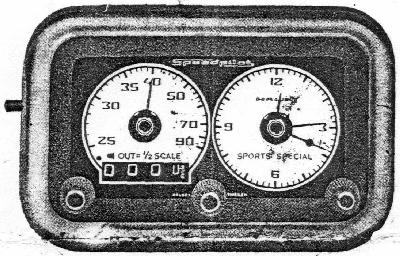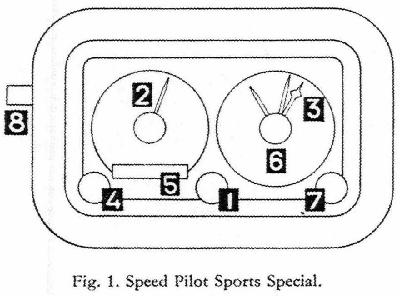|
Pilot Driving - Halda Speedpilot Sports Special
Instructions for using the Speedpilot Sports Special
as installed in the Saab Granturismo 750, 1958-62:
Pilot-driving
WITH RALLY-PROVED ENJOYMENT ADDING

THE INTERNATIONALLY - FAMOUS SWEDISH RALLY INSTRUMENT
HALDA
Speedpilot
SPORTS SPECIAL
Patented HALDA SPEED PILOT is a mechanical brain, a navigational instrument which from the first to the last moment of a run gives you exactly the information you want. It comprises 4 units: an instrument for setting your average speed, a trip meter, a "Pilot" and a clock.
 HOW TO USE THE SPEED PILOT SPORTS SPECIAL
HOW TO USE THE SPEED PILOT SPORTS SPECIAL
- Determine average speed required to reach destination at time of choice. (Kit contains "Trip-Calculator" for quick computation.)
- Set speed hand to desired average.
- Set trip meter to zero.
- JUST AS YOU START, set pilot hand to coincide with clock minute hand.
As long as you average the selected speed, the pilot hand and the minute hand will synchronize showing you are exactly on schedule. If they do not synchronize, you are as many minutes ahead or behind schedule as indicated by the pilot hand position.


- Knob for setting desired average speed between 12.5-90 m.p.h. For using 1/2 scale range turn speed hand down to red dot marked " out 1/2 scale" when signal button 8 comes out. Pressing in 8 changes over to full scale again.
- Average speed hand.
- Pilot hand (for setting pullout knob 1).
- Knob for zero-setting trip meter.
- Trip meter.
- Clock with hour and minute hands.
- Knob for clock winding (hands can be set if knob is pulled out).
- Signal-button.
|
High degree of accuracy
You can easily adjust your Speed Pilot to an accuracy within 1/2%, irrespective of r.p.m. on speedo drive. Tyre wear or change of tyres is consequently also quickly compensated.
ADJUSTMENT
The Speed Pilot is driven from a T-gear on the speedometer drive and when delivered, the mile and kilometer instruments are set for certain speedometer revs (900 revs per mile and 576 revs per kilometer respectively). It must therefore be adjusted primarily in relation to the speed drive revs of the car, which for the Saab cars are as follows according to their respective differential gear ratio (see Owner's Manual):
| Diff. gear ratio | Mile instrument | Kilometer instrument |
| 38:7 (5.43:1) | 1074 revs/mile | 667 revs/km |
| 34:7 (4.86:1) | 962 revs/mile | 598 revs/km |
Note!
The Speed Pilots, which are kept in stock by SAAB, are already adjusted for differential gear ratio 34:7, but when installing a new Speed Pilot obtained directly from Haldex it should be adjusted primarily as per the following correction table:
with Diff.
gear ratio: |
Number of turns for the primary adjustment |
| Installation in car Delivered by SAAB |
Delivered by HALDEX |
| m.p.h. | k.p.h. | m.p.h. | k.p.h. |
| 38:7 (5.43:1) | -9.8 | -9.9 | -16.2 | -13.6 |
| 34:7 (4.86:1) | 0 | 0 | -6.4 | -3.7 |
The required adjustment can be carried out very quickly by turning the adjustment screw fitted on the underside of the Speed Pilot.
FORMULA FOR FINAL ADJUSTMENT
To make the final adjustment after road test to bring the Speed Pilot to an accuracy of 99.5% the following simple formulas should be used. They will enable you to work out exactly how much the adjustment screw has to be turned and they are the same for both miles and kilometers.
The number of turns of the adjustment screw required we call "N". The distance shown on the Pilot trip meter we call "T". The distance shown on the speedometer or the measured road distance we call "D".
 We give two typical cases that can occur and they are worked out as follows. We give two typical cases that can occur and they are worked out as follows.
Pilot trip meter shows MORE than the actual distance.
The screw must be turned towards minus (-)
N = 100 - (T-D)
T
Example: Actual distance D = 3 miles.
Trip meter shows T = 3.1 miles.
Substituting these figures in the formula gives
N = 100 - (3.1 - 3) = 100 - 0.1 = 10.0 = 3.23
3.1 3.1 3.1
The screw must thus be moved 3.23 turns towards minus (-).
Pilot trip meter shows LESS than the actual distance.
The screw must be turned towards (+)
N = 100 - (D -T)
T
Example: Actual distance D = 3 miles.
Trip meter shows T = 2.9 miles.
Substituting these figures in the formula gives
N = 100 - (3 - 2.9) = 100 - 0.1 = 10.0 = 3.45
2.9 2.9 2.9
The screw must thus be moved 3.45 turns towards plus (+).
To obtain the greatest accuracy the measured road distance (D) should be at least 10 miles (20 kilometers).
|